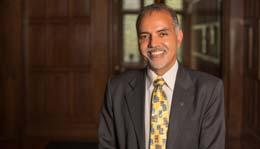Gangs and guns in Surrey what do we need to do?

By Barj Dhahan,
Special to The Post
According to Statistics Canada, Surrey has Canada’s third-worst crime problem, slightly behind much smaller towns of Grande Prairie and Red Deer in Alberta.
The Combined Forces Special Enforcement Unit of British Columbia (CFSEU-BC) says there are over 180 established criminal gangs in B.C. The RCMP's 2015 annual report on organized crime ranked Indo-Canadian groups third after bikers and Asian gangs for their strength and sophistication in B.C.'s hierarchy of criminal organizations.
But Surrey has not always been plagued by violent crime. So why is Surrey now the epicenter of gang activity and gun violence?
This question has raised many other questions in turn.
Perhaps Surrey’s crime problem is due to inadequate policing and community outreach programs for at risk youth?
Or there is a glorification of a ‘gangster’ lifestyle in certain demographic groups a factor? Are the gaming, music and movie industries a contributing factor by creating a fascination amongst youth with the ‘gang life’?
Are high housing costs and poverty possible causes?
Or is it Surrey’s geographic location and size coupled with a young, growing and diverse population making drug trade more bankable for the gangs?
Answers to such questions can aid in determining a new community based long term multi-pronged action plan to combat this complex and troubling issue.
The presence of well-established and powerful gangs like Hells Angels, Red Scorpions and the United Nations Gang along with new low-level dealers from different socio-economic backgrounds has become a huge public safety challenge.
Conflicts between rival gangs are over turf in B.C.'s lucrative drug trade. And Surrey may simply be the battleground for now. The shootings are often retaliatory in nature to maintain market share often killing targeted younger members, and sadly sometimes innocent people.
Surrey residents are fearful, angry, and frustrated. Thousands grieved together at the recent ‘Wake Up, Surrey’ rally in the aftermath of the tragic killings of two 16 and 17-year-old youth.
They are speaking up and demanding politicians, governments and law enforcement agencies to fix the problem.
They want more police officers as an immediate response to the crisis and a municipal police department in the near future. In addition there is a call for more traditional policing with more cops walking beats and doing street checks while being more visible in high traffic areas.
There are challenges in implementing these proposed solutions. Surrey has one police officer per 675 people. Vancouver has one officer per 505 people. Delta employs one officer per 593 people and; Abbotsford has one officer per 655 people.
Based on this simple comparison, Surrey could use another 250 police officers immediately and 18 to 20 more per year with the projected annual population growth. However, police strength is only one part of a complex system of resources, deployment, strategies, and tactics required to effectively maintain public safety.
Community rallies are cathartic and help to comfort and unite the residents in hope of battling the gang violence epidemic. But rallies and more police officers will not address the underlying causes.
As a society we need to do some soul searching and ask ourselves why is the drug business so lucrative in B.C?
What do we need to do to keep 11-year-olds from getting into the dangerous life of gangs and guns?
Gurdwaras, churches, temples, mosques, and other community organizations share the responsibility with governments, schools and law enforcement in keeping youth out of gangs. Municipal police departments and the RCMP are running excellent crime prevention, youth sports and outreach programs.
The Surrey WRAP and Shattering the Image efforts are good examples along with the ‘Mustang Justice’ initiative at L.A. Matheson Secondary School. More of these types of innovative approaches to support families and youth are needed.
Community organizations have facilities and resources to provide additional recreational, skills and leadership development programs for youth including counselling and parenting skills training. More prevention and intervention programs for after school hours, weekends and summers will help to keep youth out of gangs in the long run while police and criminal justice system continue to disrupt gang networks.
It is interesting to note that even with the current wave of murders in Surrey the homicide rate in the Metro Vancouver region is at a 20 year low at 1.88 murders per 100,000 people. Violent crime rate is also at historic lows.
Of the over 250 unsolved murders in the region, over two thirds were gang and drug related which are inherently difficult to solve quickly.
The overall youth crime rate and its severity have declined in the past decade, while violent crimes committed by young people have increased in severity.
On the balance our police seem to be doing an effective job in keeping us safe. Can they do more? Yes but so can we as a community.
Barj Dhahan is a member of the Vancouver Police Board.









